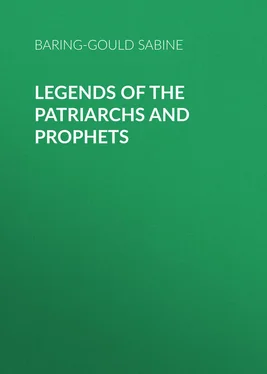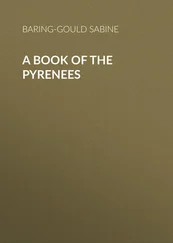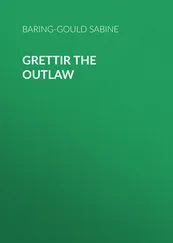Sabine Baring-Gould - Legends of the Patriarchs and Prophets
Здесь есть возможность читать онлайн «Sabine Baring-Gould - Legends of the Patriarchs and Prophets» — ознакомительный отрывок электронной книги совершенно бесплатно, а после прочтения отрывка купить полную версию. В некоторых случаях можно слушать аудио, скачать через торрент в формате fb2 и присутствует краткое содержание. Жанр: foreign_antique, foreign_prose, на английском языке. Описание произведения, (предисловие) а так же отзывы посетителей доступны на портале библиотеки ЛибКат.
- Название:Legends of the Patriarchs and Prophets
- Автор:
- Жанр:
- Год:неизвестен
- ISBN:нет данных
- Рейтинг книги:3 / 5. Голосов: 1
-
Избранное:Добавить в избранное
- Отзывы:
-
Ваша оценка:
- 60
- 1
- 2
- 3
- 4
- 5
Legends of the Patriarchs and Prophets: краткое содержание, описание и аннотация
Предлагаем к чтению аннотацию, описание, краткое содержание или предисловие (зависит от того, что написал сам автор книги «Legends of the Patriarchs and Prophets»). Если вы не нашли необходимую информацию о книге — напишите в комментариях, мы постараемся отыскать её.
Legends of the Patriarchs and Prophets — читать онлайн ознакомительный отрывок
Ниже представлен текст книги, разбитый по страницам. Система сохранения места последней прочитанной страницы, позволяет с удобством читать онлайн бесплатно книгу «Legends of the Patriarchs and Prophets», без необходимости каждый раз заново искать на чём Вы остановились. Поставьте закладку, и сможете в любой момент перейти на страницу, на которой закончили чтение.
Интервал:
Закладка:
Many are the origins attributed to man in the various creeds of ancient and modern heathendom. Sometimes he is spoken of as having been made out of water, but more generally it is of earth that he has been made, or from which he has been spontaneously born. The Peruvians believed that the world was peopled by four men and four women, brothers and sisters, who emerged from the caves near Cuzco. Among the North American Indians the earth is regarded as the universal mother. Men came into existence in her womb, and crept out of it by climbing up the roots of the trees which hung from the vault in which they were conceived and matured; or, mounting a deer, the animal brought them into daylight; or, groping in darkness, they tore their way out with their nails. 32 32 Müller, Amerikanische Urreligionen; Basle, 1855. Atherne Jones, North American Traditions, i. p. 210, etc. Heckewelder’s Indian Nations, etc.
The Egyptian philosophers pretended that man was made of the mud of the Nile. 33 33 Fourmont Anciens Peuples, i. lib. ii. p. 10.
In Aristophanes, 34 34 Aves, 666.
man is spoken of as πλάσματα πηλοῦ. Among some of the Chinese it is believed that man was thus formed: – “The book Fong-zen-tong says: When the earth and heaven were made, there was not as yet man or peoples. Then Niu-hoa moulded yellow earth, and of that made man. That is the true origin of men.” 35 35 Mémoires des Chinois, i. p. 105.
And the ancient Chaldeans supposed man was made by the mixing of the blood of Belus with the soil. 36 36 Berosus, in Cory’s Ancient Fragments, p. 26.
In 1655, Isaac de la Peyreira, a converted Jew, published a curious treatise on the Pre-Adamites. Arguing upon Romans v. 12-14, he contended that there were two creations of man; that recorded in the first chapter of Genesis and that described in the second chapter being distinct. The first race he supposed to have peopled the whole world, but that it was bad, and therefore Adam had been created with a spiritual soul, and that from Adam the Jewish race was descended, whereas the Gentile nations issued from the loins of the Pre-Adamites. Consequently the original sin of Adam weighed only on his descendants, and Peyreira supposed that it was his race alone which perished, with the exception of Noah and his family, in the Deluge, which Peyreira contends was partial. This book was condemned and burnt in Paris by the hands of the executioner, and the author, who had taken refuge in Brussels, was there condemned by the ecclesiastical authorities. He appealed to Rome, whither he journeyed, and he was received with favor by Alexander VII., before whom he abjured Calvinism, which he had professed.
He died at the age of 82, at Aubervilliers, near Paris, and Moreri wrote the following epigrammatic epitaph for him: —
“La Peyrère ici gît, ce bon Israélite,
Huguenot, catholique, enfin pré-Adamite.
Quatre religions lui plurent à la fois;
Et son indifférence était si peu commune,
Qu’après quatre-vingts ans qu’il eut à faire un choix,
Le bon homme partit et n’en choisit aucune.”
The Oriental book Huschenk-Nameh gives a fuller history of the Pre-Adamites. Before Adam was created, says this book, there were in the isle Muscham, one of the Maldives, men with flat heads, and for this reason they were called by the Persians, Nim-ser. They were governed by a king named Dambac.
When Adam, expelled the earthly Paradise, established himself in the Isle of Ceylon, the flat-heads submitted to him. After his death they guarded his tomb by day, and the lions relieved guard by night, to protect his body against the Divs.
III
EVE. 37 37 It is unfortunate that I have already written on the myths relating to the formation of Eve in “Curiosities of Olden Times.” I would therefore have omitted a chapter which must repeat what has been already published, but that by so doing I should leave this work imperfect. However, there is much in this chapter which was not in the article referred to.
That man was created double, i. e. both male and female, is and has been a common opinion. One Rabbinical interpretation of the text, “And God created man in His own image, male-female created He them,” is that Adam and Eve were formed back to back, united at the shoulders, and were hewn asunder with a hatchet; but of this more presently. The Rabbis say that when Eve had to be drawn out of the side of Adam she was not extracted by the head, lest she should be vain; nor by the eyes, lest they should be wanton; nor by the mouth, lest she should be given to gossiping; nor by the ears, lest she should be an eavesdropper; nor by the hands, lest she should be meddlesome; nor by the feet, lest she should be a gadabout; nor by the heart, lest she should be jealous; but she was drawn forth by the side: yet, notwithstanding all these precautions, she has every fault specially guarded against. 38 38 Rabboth, fol. 20 b.
They also say that, for the marriage-feast of Adam and Eve, God made a table of precious stone, and each gem was a hundred ells long and sixty ells wide, and the table was covered with costly dishes. 39 39 Eisenmenger, i. 830.
The Mussulman tradition is, that Adam having eaten the bunch of grapes given him as a reward for having preached to the angels, fell asleep; and whilst he slept, God took from his left side a woman whom He called Hava, because she was extracted from one living (Hai), and He laid her beside Adam. She resembled him exactly, except that her features were more delicate, her hair longer and divided into seven hundred locks, her form more slender, her eyes softer, and her voice sweeter than Adam’s. In the mean time Adam had been dreaming that a wife had been given to him; and when he woke, great was his delight to find his dream turned into a reality. He put forth his hand to take that of Hava, but she withdrew hers, answering his words of love with, “God is my master, and I cannot give my hand to thee without His permission; and, moreover, it is not proper for a man to take a wife without making her a wedding present.”
Adam thereupon sent the angel Gabriel to ask God’s permission to take to him Hava as his wife. Gabriel returned with the answer that she had been created to be his helpmate, and that he was to treat her with gentleness and love. For a present he must pray twenty times for Mohammed and for the prophets, who, in due season, were to be born of him. Ridhwan, the porter of Paradise, then brought to Adam the winged horse Meimun, and to Eve a light-footed she-camel. Gabriel helped them to mount and led them into Paradise, where they were greeted by all the angels and beasts with the words: “Hail, father and mother of Mohammed!”
In the midst of Paradise was a green silk tent spread for them, supported on gold pillars, and in the tent was a throne upon which Adam and Hava were seated. Then they were bathed in one of the rivers of Paradise and brought before the presence of God, who bade them dwell in Paradise. “I have prepared you this garden for your home; in it you shall be protected from cold and heat, from hunger and thirst. Enjoy all that meets your eye, only of one fruit taste not. Beware how you break my command, and arm yourself against the subtlety of your foe, Eblis; he envies you, and stands by you seeking to destroy you, for through you was he cast out.” 40 40 Weil, pp. 17, 18.
Tabari says that Adam was brought single into Paradise, through which he roamed eating from the fruit trees, and a deep sleep fell upon him, during which Eve was created from his left side. And when Adam opened his eyes, he saw her, and asked her who she was, and she replied, “I am thy wife; God created me out of thee and for thee, that thy heart might find repose.” The angels said to Adam: “What thing is this? What is her name? Why is she made?” Adam replied, “This is Eve.” Adam remained five hundred years in Paradise. It was on a Friday that Adam entered Eden. 41 41 Tabari, i. c. xxvi.
Интервал:
Закладка:
Похожие книги на «Legends of the Patriarchs and Prophets»
Представляем Вашему вниманию похожие книги на «Legends of the Patriarchs and Prophets» списком для выбора. Мы отобрали схожую по названию и смыслу литературу в надежде предоставить читателям больше вариантов отыскать новые, интересные, ещё непрочитанные произведения.
Обсуждение, отзывы о книге «Legends of the Patriarchs and Prophets» и просто собственные мнения читателей. Оставьте ваши комментарии, напишите, что Вы думаете о произведении, его смысле или главных героях. Укажите что конкретно понравилось, а что нет, и почему Вы так считаете.












